2003 PONTIAC GRAND PRIX window
[x] Cancel search: windowPage 227 of 378

Section 5 Service and Appearance Care
Appearance Care ............................................ 5.88
Cleaning the Inside of Your Vehicle ................. 5-88
Weatherstrips ............................................... 5-91
Sheet Metal Damage
..................................... 5-93
Finish Damage
............................................. 5-93
Underbody Maintenance
................................ 5-93
Chemical Paint Spotting
................................. 5-94
GM Vehicle CarelAppearance Materials
......... -5-94
Vehicle Identification ...................................... 5-96
Vehicle Identification Number (VIN)
................. 5-96
Service Parts Identification Label
..................... 5-96
Care
of Safety Belts
...................................... 5-91
Cleaning the Outside of Your Vehicle
.............. 5-91
Electrical System .................................... 5.97
Add-on Electrical Equipment
.......................... 5.97
Headlamp Wiring
......................................... 5-97
Windshield Wiper Fuses
................................ 5.97
Power Windows and Other Power Options
....... 5-97
Fuses and Circuit Breakers
........................... 5-97
Capacities and Specifications ........................ 5.102
Capacities and Specifications
........................ 5.102
Normal Maintenance Replacement Parts ......... 5.104
Normal Maintenance Replacement Parts
......... 5.104
5-2
Page 260 of 378
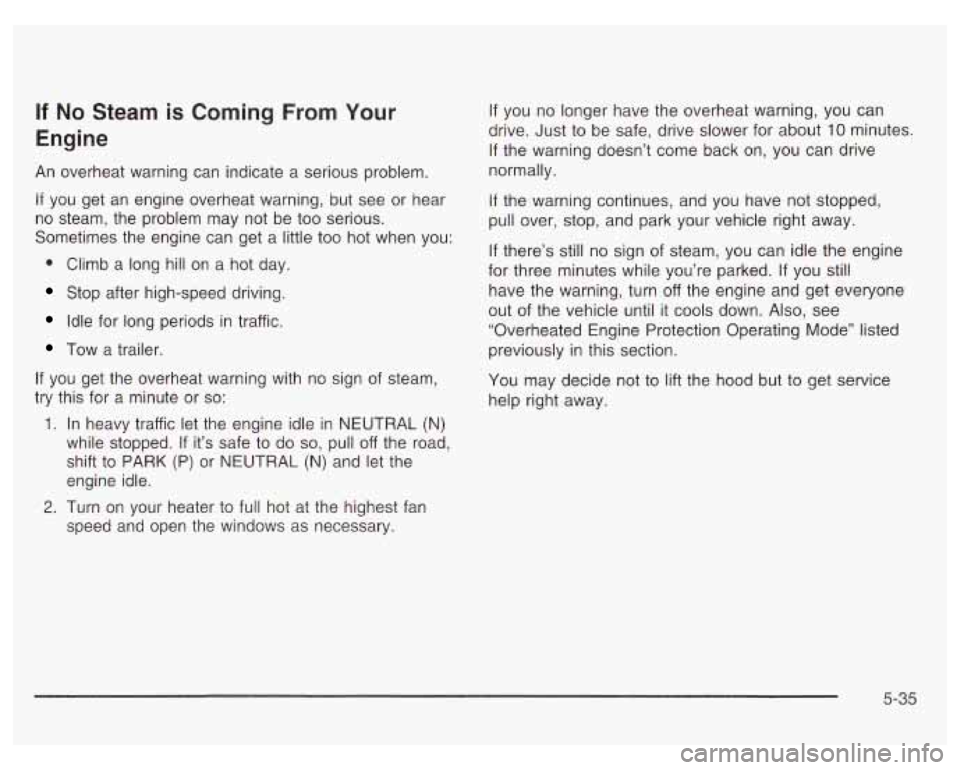
If No Steam is Coming From Your
Engine
An overheat warning can indicate a serious problem.
If you get an engine overheat warning, but see or hear
no steam, the problem may not be too serious.
Sometimes the engine can get a little too hot when you:
Climb a long hill on
a hot day.
Stop after high-speed driving.
Idle for long periods in traffic.
Tow a trailer.
If you get the overheat warning with no sign
of steam,
try this for a minute or
so:
1. In heavy traffic let the engine idle in NEUTRAL (N)
while stopped.
If it’s safe to do so, pull off the rozd,
shift to PARK
(P) or NEUTRAL (N) and let the
engine idle.
If you no longer have the overheat warning, you can
drive. Just to be safe, drive slower for about
10 minutes.
If the warning doesn’t come back on, you can drive
normally.
If the warning continues, and you have not stopped,
pull over, stop, and park your vehicle right away.
If there’s still no sign of steam, you can idle the engine
for three minutes while you’re parked. If you still
have the warning, turn off the engine and get everyone
out of the vehicle until it cools down. Also, see
“Overheated Engine Protection Operating Mode” listed
previously in this section.
You may decide not to lift the hood but to get service
help right away.
2. Turn on your heater to full hot at the highest fan
speed and open the windows as necessary.
5-35
Page 313 of 378
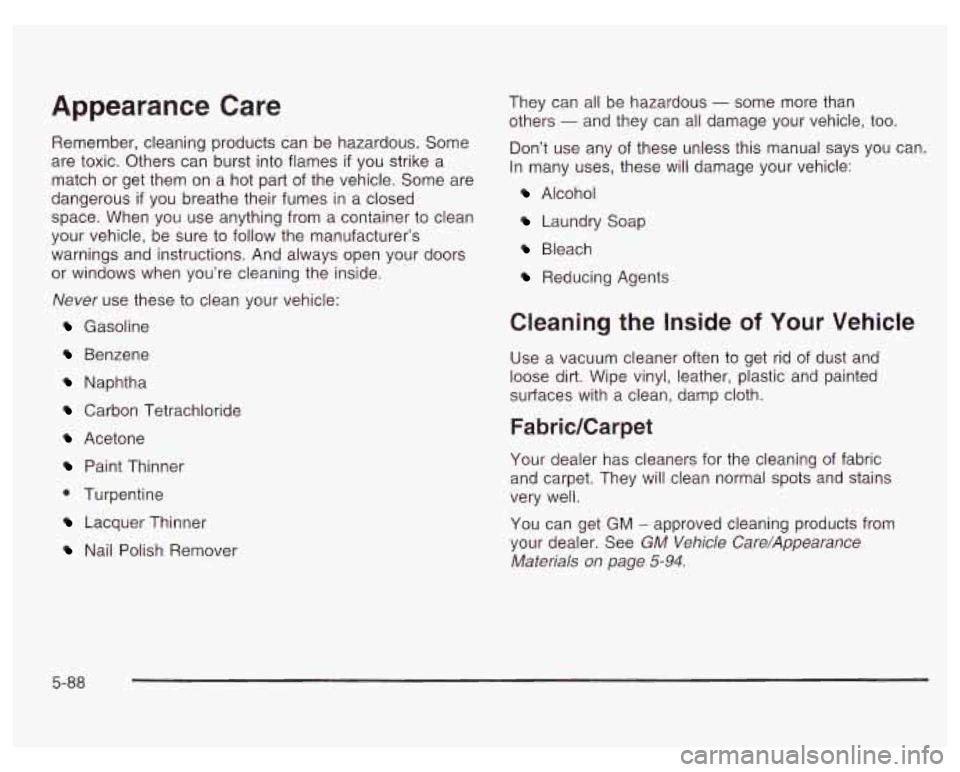
Appearance Care
Remember, cleaning products can be hazardous. Some
are toxic. Others can burst into flames
if you strike a
match or get them on a hot part of the vehicle. Some are
dangerous
if you breathe their fumes in a closed
space. When you use anything from a container to clean
your vehicle, be sure to follow the manufacturer’s
warnings and instructions. And always open your doors
or windows when you’re cleaning the inside.
Never use these to clean your vehicle:
Gasoline
Benzene
Naphtha
Carbon Tetrachloride
Acetone
Paint Thinner
Turpentine
Lacquer Thinner
Nail Polish Remover They can
all be hazardous
- some more than
others
- and they can all damage your vehicle, too.
Don’t use any of these unless this manual says you can.
In many uses, these will damage your vehicle:
Alcohol
Laundry Soap
Bleach
Reducing Agents
Cleaning the Inside of Your Vehicle
Use a vacuum cleaner often to get rid of dust and
loose dirt. Wipe vinyl, leather, plastic and painted
surfaces with
a clean, damp cloth.
FabridCarpet
Your dealer has cleaners for the cleaning of fabric
and carpet. They will clean normal spots and stains
very well.
You can get
GM - approved cleaning products from
your dealer. See
GM Vehicle Care/Appearance
Materials
on page 5-94.
5-88
Page 315 of 378
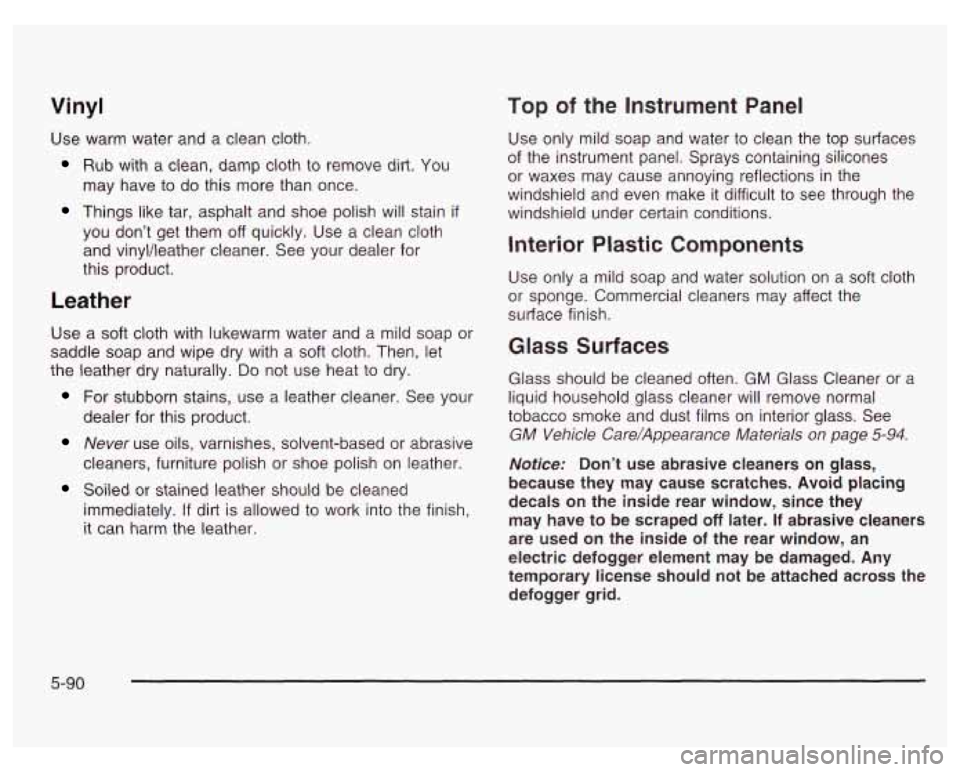
Vinyl
Use warm water and a clean cloth.
Rub with a clean, damp cloth to remove dirt. You
may have to do this more than once.
Things like tar, asphalt and shoe polish will stain if
you don’t get them off quickly. Use a clean cloth
and vinyVleather cleaner. See your dealer for
this product.
Leather
Use a soft cloth with lukewarm water and a mild soap or
saddle soap and wipe dry with a soft cloth. Then, let
the leather
dry naturally. Do not use heat to dry.
For stubborn stains, use a leather cleaner. See your
dealer for this product.
Never use oils, varnishes, solvent-based or abrasive
cleaners, furniture polish or shoe polish on leather.
Soiled or stained leather should be cleaned
immediately.
If dirt is allowed to work into the finish,
it can harm the leather.
Top of the Instrument Panel
Use only mild soap and water to clean the top surfaces
of the instrument panel. Sprays containing silicones
or waxes may cause annoying reflections in the
windshield and even make it difficult to see through the
windshield under certain conditions.
Interior Plastic Components
Use only a mild soap and water solution on a soft cloth
or sponge. Commercial cleaners may affect the
surface finish.
Glass Surfaces
Glass should be cleaned often. GM Glass Cleaner or a
liquid household glass cleaner will remove normal
tobacco smoke and dust films on interior glass. See
GM Vehicle Care/Appearance Materials on page
5-94.
Notice: Don’t use abrasive cleaners on glass,
because they may cause scratches. Avoid placing
decals on the inside rear window, since they
may have to be scraped
off later. If abrasive cleaners
are used on the inside
of the rear window, an
electric defogger element may be damaged. Any
temporary license should not be attached across the
defogger grid.
5-90
Page 322 of 378
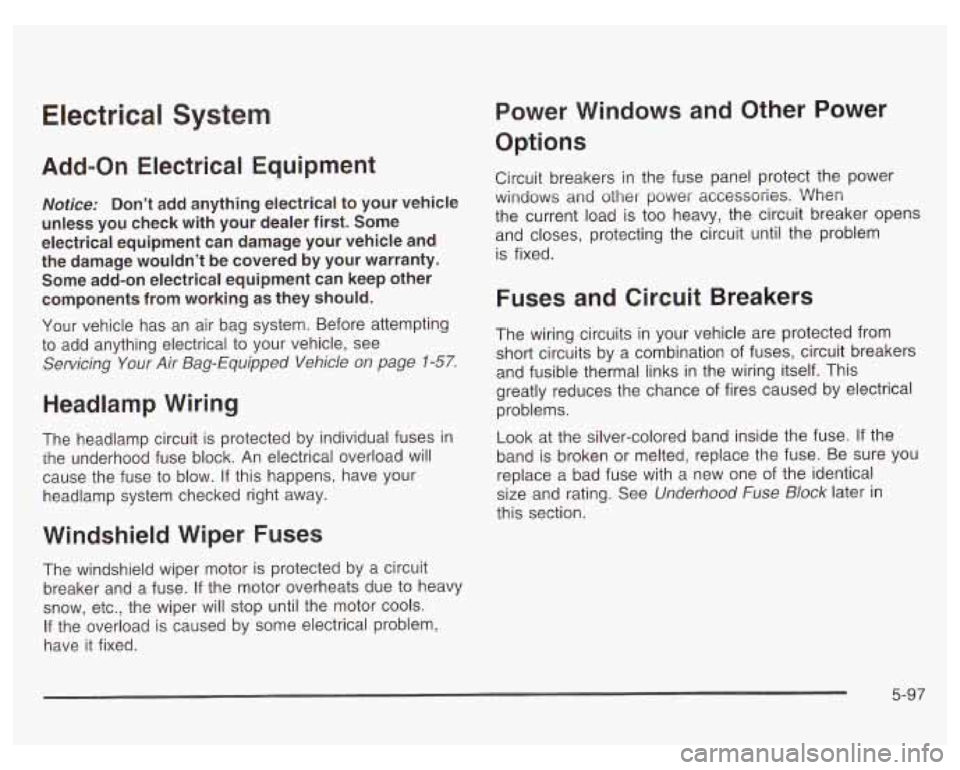
Electrical System
Add-on Electrical Equipment
Notice: Don’t add anything electrical to your vehicle
unless you check with your dealer first. Some
electrical equipment can damage your vehicle and
the damage wouldn’t be covered by your warranty.
Some add-on electrical equipment can keep other
components from working as they should.
Your vehicle has an air bag system. Before attempting
to add anything electrical to your vehicle, see
Servicing Your Air Bag-Equipped Vehicle on page
1-57.
Headlamp Wiring
The headlamp circuit is protected by individual fuses in
the underhood fuse block. An electrical overload will
cause the fuse to blow. If this happens, have your
headlamp system checked right away.
Windshield Wiper Fuses
The windshield wiper motor is protected by a circuit
breaker and
a fuse. If the motor overheats due to heavy
snow, etc., the wiper will stop until the motor cools.
If the overload is caused by some electrical problem,
have it fixed.
Power Windows and Other Power
Options
Circuit breakers in the fuse panel protect the power
windows
and other power accessories. When
the current load is too heavy, the circuit breaker opens
and closes, protecting the circuit until the problem
is fixed.
Fuses and Circuit Breakers
The wiring circuits in your vehicle are protected from
short circuits by a combination of fuses, circuit breakers
and fusible thermal links in the wiring itself. This
greatly reduces the chance of fires caused by electrical
problems.
Look at the silver-colored band inside the fuse. If the
band is broken or melted, replace the fuse. Be sure you
replace a bad fuse with a new one of the identical
size and rating. See Underhood Fuse Block later in
this section.
5-97
Page 323 of 378

Instrument Panel Fuse Block
Some fuses are in a fuse block located inside of the
glove box behind a small bin on the right side.
To open,
pull the cover out. The fuse block is inside. On the
back edge of this cover is a fuse usage chart.
To reinstall the bin, position the lower end and turn the
top into position. Press on the sides until it snaps
into place.
CIRCUIT
BREAKERS
(HEADLAMPI
I
I I MALLPGM I MALL I WIPER I I STR WHL
ILLUM I 'TT:rL SUNROOF RADIO
PASSKEY
111
CRUISE
I PWR LOCK
HAZARD
r
FUSE USAGE CHARTI I
STOP LAMP
I/P-IGN HSEATILUM
PWR MIR
ONSTAR
SIR
HVAC
CTRL
R DEFOG
HVAC
HI
TURN
BTSl
DICIHVAC
For More Information. See Owner's Manual
Circuit
Usage
Breakers
HEADLAMP Headlamps
SEAT Power Seat, Power Lumbar
BLANK Blank
PWR WDO Power Windows
I BLANK Bian k
BLANK Blank
BLANK Blank
5-98
Page 324 of 378
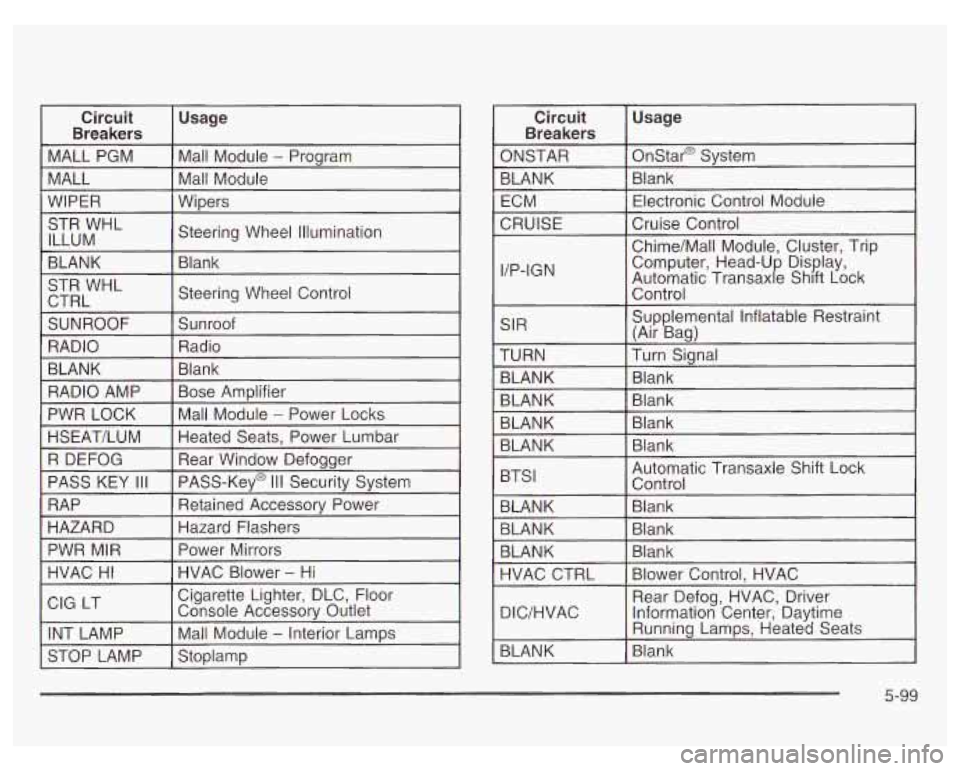
Circuit
Breakers
MALL PGM
MALL
WIPER STR WHL
ILLUM
BLANK
STR WHL
CTRL
SUNROOF RADIO
BLANK
RADIO AMP
PWR LOCK
HSEAT/LUM
I Usage
Mall Module - Program
Mall Module
~~ ~~
-
Wipers
Steering Wheel Illumination
Blank
Steering Wheel Control
Sunroof
Radio
R DEFOG Rear Window Defogger
PASS KEY
Ill PASS-Key@ I II Security System
~~ ~
lRAP I Retained Accessow Power I
ONSTAR Onstar@
System
BLANK Blank
SIR Supplemental
Inflatable Restraint
(Air Baa)
BTSl
I
Automatic Transaxle Shift Lock
Control
5-99
Page 363 of 378
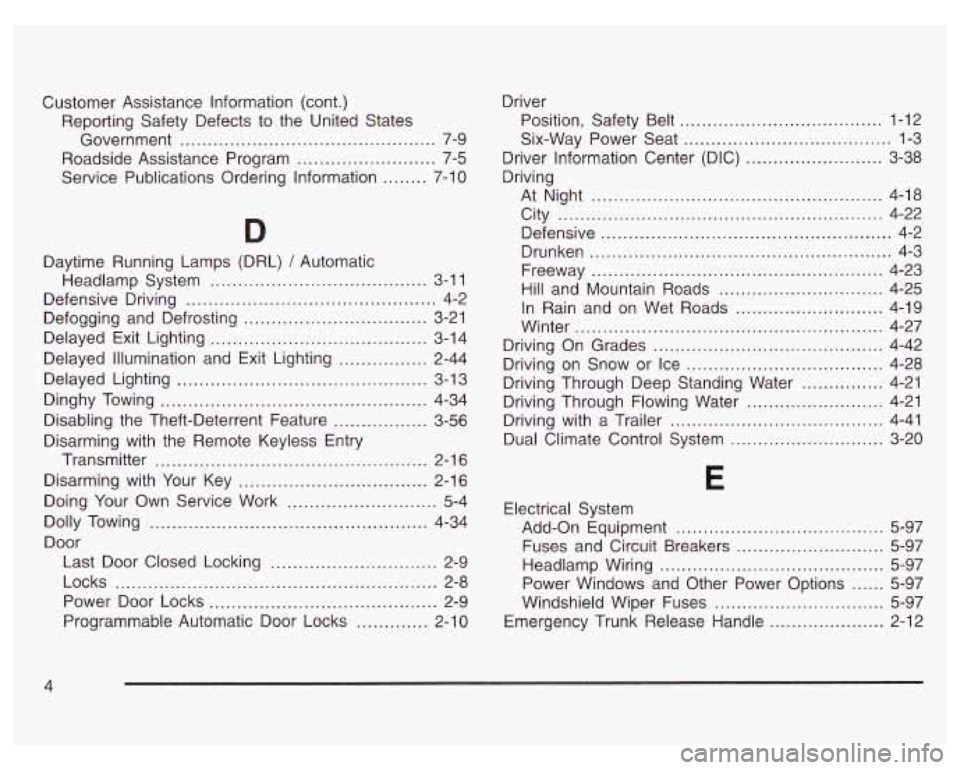
Customer Assistance Information (cont.)
Reporting Safety Defects to the United States
Government
.............................................. 7-9
Roadside Assistance Program
......................... 7-5
Service Publications Ordering Information
........ 7-1 0
D
Daytime Running Lamps (DRL) / Automatic
Headlamp System
....................................... 3-1 1
Defensive Driving ............................................. 4-2
Defogging and Defrosting
................................. 3-21
Delayed Exit Lighting
....................................... 3-14
Delayed Illumination and Exit Lighting
................ 2-44
Delayed Lighting
............................................. 3-1 3
Dinghy Towing
................................................ 4-34
Disabling the Theft-Deterrent Feature
................. 3-56
Disarming with the Remote Keyless Entry
Transmitter
................................................. 2-1 6
Disarming with Your Key
.................................. 2-16
Doing Your Own Service Work
........................... 5-4
Dolly Towing
.................................................. 4-34
Door Last Door Closed Locking
.............................. 2-9
Power Door Locks
......................................... 2-9
Programmable Automatic Door Locks
............. 2-1 0
Locks .......................................................... 2-8 Driver
Position. Safety Belt
..................................... 1-12
Six-Way Power Seat
...................................... 1-3
Driver Information Center (DIC)
......................... 3-38
Driving At Night
..................................................... 4-18
City
........................................................... 4-22
Defensive
..................................................... 4-2
Drunken
....................................................... 4-3
Freeway
..................................................... 4-23
Hill and Mountain Roads
.............................. 4-25
In Rain and on Wet Roads
........................... 4-19
Winter
........................................................ 4-27
Driving On Grades
.......................................... 4-42
Driving on Snow or Ice
.................................... 4-28
Driving Through Deep Standing Water
............... 4-21
Driving Through Flowing Water
......................... 4-21
Dual Climate Control System
............................ 3-20
Driving with
a Trailer
....................................... 4-41
Electrical System
Add-on Equipment
.......... ................. 5-97
Fuses and Circuit Breakers
................... 5-97
Headlamp Wiring
......................................... 5-97
Power Windows and Other Power Options
...... 5-97
Windshield Wiper Fuses
............................... 5-97
Emergency Trunk Release Handle
................. 2-12
4